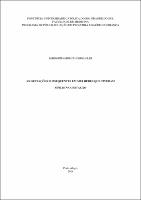| Share record |


|
Please use this identifier to cite or link to this item:
https://tede2.pucrs.br/tede2/handle/tede/1441| Document type: | Dissertação |
| Title: | As gestações subsequentes em mulheres que tiveram sífilis na gestação |
| Author: | Hebmuller, Marjorie Garlow  |
| Advisor: | Fiori, Humberto Holmer |
| Abstract (native): | Importância: Muitos esforços têm ocorrido em identificar os fatores de risco e as causas da persistência da sífilis congênita (SC) ao longo dos anos, e muitas vezes a repetição de casos em uma mesma mulher. No Rio Grande do Sul, ainda não existe um estudo sobre a reincidência da SC, suas causas e seus desfechos. Objetivos: Investigar as gestações subsequentes em mulheres que tiveram sífilis na gestação. Material e métodos: A população de estudo foram as pacientes atendidas no Centro Obstétrico do HSL cujos eventos obstétricos ocorreram entre maio de 1997 e dezembro de 2004. Foram incluídas todas as pacientes que tiveram sífilis antes ou durante a gestação e tiveram recém-nascidos vivos, abortos ou natimortos com sífilis congênita, assim como pacientes adequadamente tratadas para sífilis antes do parto, que deram à luz recém-nascidos vivos sem sífilis congênita. Os casos de sífilis congênita foram definidos conforme os critérios do Ministério da Saúde (anexo 1). O levantamento das gestações subsequentes incluiu o período até dezembro de 2011. Os dados foram analisados no programa Epi Info 3.4, utilizando-se o teste de χ² ou teste exato de Fisher para associações, e o teste Mann-Whitney-Wilcoxon para comparações de medianas. O nível de significância foi estabelecido como p < 0,05. Resultados: Foram identificadas 450 mulheres com testes positivos para sífilis com pelo menos um evento obstétrico no HSL entre maio de 1997 e dezembro de 2004, das quais 166 tiveram pelo menos mais um evento subsequente no mesmo hospital até dezembro de 2011. Os casos de SC foram de 82% nos eventos iniciais e 68,5% nos subsequentes (OR 2,09, IC95% 1,3-3,3). Entre as pacientes com SC no evento inicial, 72% tiveram pelo menos mais um evento com SC, contra 56,6% das pacientes sem SC no evento inicial (OR 1,97, CI95% 0,9-4,4). Conclusões: Ocorreram muitos de casos de SC com desfechos adversos nas gestações subsequentes, embora em menor número do que nas iniciais. Suspeita-se que mais recém-nascidos não infectados possam ter sido definidos como casos de sífilis congênita nas gestações subsequentes, em virtude da falta de registros dos antecedentes maternos e da ausência ou inadequação do acompanhamento pré-natal. É importante aumentar a vigilância sobre as mulheres que já tiveram uma gestação com sífilis. |
| Abstract (english): | Importance: Many efforts have ocurred in identify risk factors and causes of congenital syphilis (CS) persistence along years, and in many cases, the repetition of the condition in the same woman. In Rio Grande do Sul, there are no studies about the reincidence of CS, its causes and outcomes. Objectives: To investigate the next pregnancies in women who already had syphilis in a previous pregnancy. Methods: The study sample were women with obstetrical events ocurred in São Lucas Hospital (SLH) between may 1997 and december 2004. We included all patients with syphilis before or during pregnancy who had newborns, stillborns or abortions with CS, as patients correctly treated for syphilis before delivery and that had newborns without syphilis. The CS cases were defined according to the Brazilian Ministry of Health (appendix 1). The follow-up period for the subsequent pregnancies was until december 2011. The data were analised in program Epi Info 3.4, using the χ² test or Fisher exact test for associations, and Mann-Whitney-Wilcoxon test for comparison of medians. The level of significance was set at p < 0,05. Results: We identified 450 women with positive tests for syphilis that had at least one obstetrical event in SLH between may 1997 and december 2004, within 166 had at least one more obstetrical event in the same hospital until december 2011.Cases of CS were 82% in the initial events and 68,5% in the subsequent s (OR 2,09, CI95% 1,3-3,3). Within patients with CS in the initial event, 72% had at least one more pregnancy with CS, against 56,6% of patiens without CS in the initial event(OR 1,97, CI95% 0,9-4,4). Conclusions: Many cases of CS with adverse outcomes ocurred in the subsequent pregnancies, although less than in the initial events. It is suspected that more uninfected newborns may have been defined as cases of congenital syphilis in subsequent pregnancies, because of the lack of records of maternal history and the absence or inadequacy of prenatal care. It is important to increase surveillance on women who have already had one pregnancy with syphilis. |
| Keywords: | MEDICINA PEDIATRIA SÍFILIS SÍFILIS CONGÊNITA CUIDADO PRÉ-NATAL GESTAÇÃO RECÉM-NASCIDO PREMATUROS |
| CNPQ Knowledge Areas: | CNPQ::CIENCIAS DA SAUDE::MEDICINA |
| Language: | por |
| Country: | BR |
| Publisher: | Pontifícia Universidade Católica do Rio Grande do Sul |
| Institution Acronym: | PUCRS |
| Department: | Faculdade de Medicina |
| Program: | Programa de Pós-Graduação em Medicina/Pediatria e Saúde da Criança |
| Citation: | HEBMULLER, Marjorie Garlow. As gestações subsequentes em mulheres que tiveram sífilis na gestação. 2014. 18 f. Dissertação (Mestrado em Pediatria e Saúde da Criança) - Pontifícia Universidade Católica do Rio Grande do Sul, Porto Alegre, 2014. |
| Access type: | Acesso Aberto |
| URI: | http://tede2.pucrs.br/tede2/handle/tede/1441 |
| Issue Date: | 18-Aug-2014 |
| Appears in Collections: | Programa de Pós-Graduação em Pediatria e Saúde da Criança |
Files in This Item:
| File | Description | Size | Format | |
|---|---|---|---|---|
| 462202.pdf | Texto Parcial | 265.34 kB | Adobe PDF |  Download/Open Preview |
Items in DSpace are protected by copyright, with all rights reserved, unless otherwise indicated.




